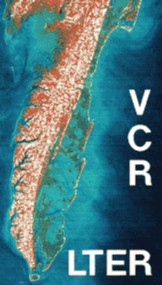 Experimental Effects of Wrack Deposition and Plant Community Type on Salt Marsh Infauna |

Steve Roberts and Dave Yozzo
Department of Biology
|
 Experimental Effects of Wrack Deposition and Plant Community Type on Salt Marsh Infauna |

Steve Roberts and Dave Yozzo
Department of Biology
|
The present study focuses on the macrofaunal community of an organic high marsh. It compares the benthic invertebrates of Juncus roemerianus dominated and Spartina patens/Distichlis spicata co-dominated communities. Specifically, this experiment gives a better understanding of the effects of wrack deposition and plant community type on marsh infaunal abundance and distribution. Species composition, abundance, and biomass are compared between: (1) wrack and non-wrack treatments; (2) J. roemerianus and S. patens/D. spicata mixed communities; (3) spring and summer sampling in 1995.
The plots were approximately 35 meters from the head of a tributary of Phillips Creek, located in the high marsh. Samples were collected during Spring (April 1995), and summer (July 1995). An aluminium core tube 10cm in diameter was used to extract 24 cores at a depth of 10cm on each date. Two samples were collected from each of the four subdivisions: (1) J. roemerianus/wrack; (2) J.roemerianus/non-wrack; (3) mixed community/wrack; (4) mixed community/non-wrack. These subdivisions were assembled in 3 replicate unenclosed control plots(#'s 1,6, and 8).
Once samples were identified and counted, a wet mass was determined to four significant figures after blotting on paper towels, (note the hydrobiid snail, Melampus bidentatus, were weighed after extracting the meat from the shell). Means and standard error, (SE), were determined for total abundance and total biomass. Means + SE were calculated for Tubificidae, Naididae, Gammarus palustrus, and Melampus bidentatus.
A total of 6 taxa accounted for 1,146 individual organisms in the spring sample. The dominant animals most consistently collected with the corer were two groups of oligochaetes, tubificids and naids. Table 1).
A total of 5 taxa were represented by 410 organisms in the summer sample, a decrease in one taxa and 736 organisms. The dominant organisms were oligochaetes. The mixed community/non-wrack plot yielded the highest mean biomass at 0.081g/core + 0.036. Mixed community/non-wrack and J. roemerianus/wrack yielded the highest, and near identical total abundance means of 22.50 individuals/core + 6.144 and 22.53 individuals/core + 5.766 respectively.
This experiment supports the statement that oligochaetes are among the numerically dominant and evenly distributed organisms in a salt marsh (Wenner and Beatty 1988). It further agrees with other studies in that a peak in infaunal density occurs during the spring and/or fall, and the lowest density in the summer (Bell 1982, Cammen 1979, Kneib and Stiven 1982). However, data do not support the suggestion proposed by Wenner and Beatty (1988), that physical characteristics of a community are more influential than the sampling period. The mean abundance collected does not clearly show a specific preference between wrack and non-wrack treatments, or between plant types. The fall 1995 sample is currently being analyzed and will perhaps shed new light on overall distributions.
BELL, S.S. 1982. On the population biology and meiofaunal characteristics of Manukia aestuarina (Polychaeta: Sabellidae: Fabricinae ) from a South Carolina salt marsh. Estuarine Coastal Shelf Sci. 14: 215-221.
CAMMEN, L.M. 1979. The macro-infauna of a North Carolina salt marsh. Am. Midl. Nat. 102: 244-253.
KNEIB, R.T. and A.E. STIVEN. 1982. Benthic invertebrate responses to density manipulations of the common mummichog, in an intertidal salt marsh. Ecology. 63: 1518-1532.
WENNER, E.L. and H.R. BEATTY. 1988. Macrobenthic communities from wetland impoundments and adjacent open marsh habitats in South Carolina. Estuaries. 11: 29-44.